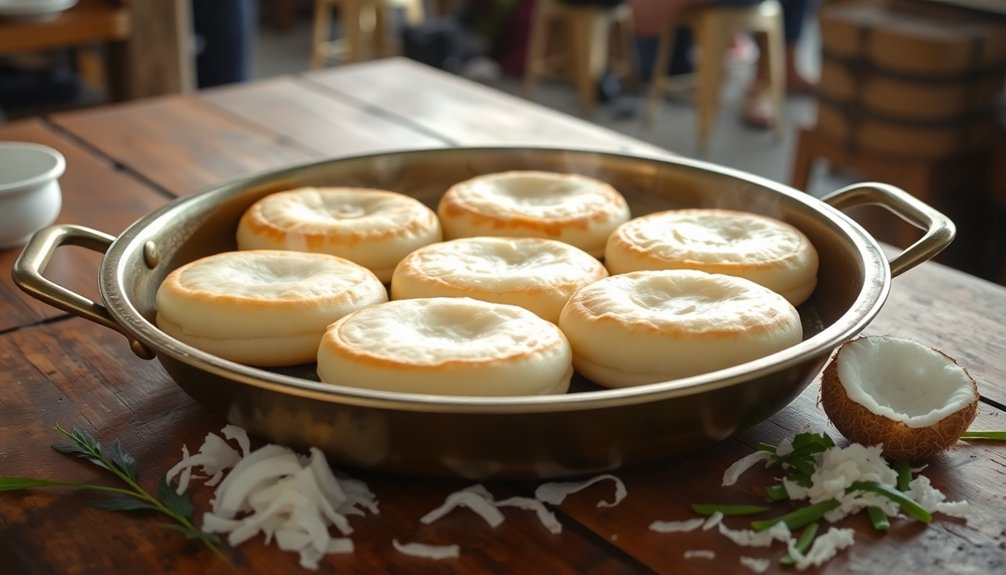Khanom Krok – Coconut-Rice Pancakes
Khanom Krok are delicate Thai coconut-rice pancakes with crispy edges and soft, custardy centers. Dating back to the Sukhothai Kingdom (1238-1438), these treats blend rice flour, tapioca flour, and coconut milk cooked in specialized dimpled pans. You’ll find them topped with green onions, corn, or additional coconut cream at street markets throughout Thailand. Mastering these little pancakes connects you to centuries of Thai culinary tradition—a journey worth every satisfying, creamy bite.
Key Takeaways
- Khanom Krok are traditional Thai coconut-rice pancakes with crispy edges and soft, custard-like centers.
- Made primarily with rice flour, tapioca flour, coconut milk, and coconut cream for authentic flavor.
- Cooked in a special indented pan that creates their characteristic dome shape.
- Typically topped with green onions or corn kernels before being covered and cooked for 5-6 minutes.
- Originated during the Sukhothai Kingdom (1238-1438) and remains an important Thai street food.
History

Though its exact origins remain unclear, Khanom Krok has been a staple of Thai cuisine since at least the Sukhothai Kingdom (1238-1438).
You’ll find that historians debate whether the dish emerged independently in Thailand or was adapted from Indian or Chinese influences.
During the Ayutthaya period (1350-1767), these coconut pancakes gained significant cultural significance as offerings in Buddhist ceremonies.
Recipe

Ingredients
- 1 cup rice flour
- 1/4 cup tapioca flour
- 1 cup coconut milk
- 1/2 cup coconut cream
- 3 tablespoons sugar
- 1/2 teaspoon salt
- 2 tablespoons cooked jasmine rice
- 2 tablespoons grated coconut
- Green onions or corn kernels for topping (optional)
Instructions
- Soak the cooked jasmine rice in water for 10 minutes, then drain well.
- In a blender, combine rice flour, tapioca flour, coconut milk, sugar, salt, and the soaked rice. Blend until smooth.
- Let the batter rest for at least 30 minutes.
- Heat a khanom krok pan (or a special pancake pan with half-sphere molds) over medium heat.
- Brush the molds lightly with vegetable oil.
- Fill each mold about 2/3 full with the batter.
- When the edges start to set, add a small spoonful of coconut cream and sprinkle with grated coconut.
- Add optional toppings like green onions or corn kernels.
- Cover with a lid and cook for about 5-6 minutes until golden brown and crispy on the outside.
- Use a spoon to gently remove the pancakes from the molds.
- Serve warm.
Cooking Steps

To prepare khanom krok properly, you’ll need to heat your cast iron pan until it’s smoking hot before carefully pouring the coconut batter into each dimple.
After the edges begin to set, you’ll gently add your chosen filling, whether it’s green onions, corn, or taro, then cover the pan to create the steamy environment that guarantees proper cooking.
Once the pancakes develop their signature golden-brown edges and firm texture, you’ll delicately remove each one with a traditional bamboo pick, just as Thai street vendors have done for generations.
Step 1. Heat Cast Iron Pan
Place your traditional Khanom Krok pan over medium heat, allowing the heavy cast iron to absorb the heat evenly for 3-5 minutes. Proper heat distribution is essential for creating the signature crispy exterior and soft, custardy interior that defines these ancient Thai street treats.
You’ll know your pan has reached the perfect temperature when a drop of water sizzles and evaporates immediately upon contact.
- Test the pan’s readiness by dropping a small amount of coconut oil – it should shimmer but not smoke
- Watch for subtle color changes in the seasoned cast iron as it shifts from black to a slightly ashen hue
- Position the pan so flames or heat elements contact only the dimpled portions for best cooking
step 2. Pour Coconut Batter
The perfect pouring technique begins with a gentle swirl of your prepared coconut-rice batter before ladling it into each dimple of your now-heated Khanom Krok pan, filling each depression approximately three-quarters full.
The coconut consistency should resemble thick cream—fluid enough to pour smoothly yet substantial enough to hold its form. Notice how the edges immediately begin to bubble and set while the center remains liquid.
This centuries-old Thai street food technique requires patience and precision. When pouring, use a small ladle or measuring spoon with a spout for control, holding it about an inch above the pan.
Batter pouring is perhaps the most essential moment in creating authentic Khanom Krok—too little yields thin, crispy cakes; too much causes overflow and burning.
Listen for the satisfying sizzle confirming your pan has reached ideal temperature.
Step 3. Add Filling Carefully
With the batter now sizzling in each depression of your pan, focus shifts toward adding your carefully prepared fillings.
Traditional khanom krok, dating back to the Sukhothai period (1238-1438), employs a careful balance between sweet and savory elements.
You’ll need to work quickly but precisely, adding just enough filling to complement—never overwhelm—the delicate coconut base.
- Sprinkle corn kernels, green onions, or taro cubes in the center while the edges remain slightly runny
- Drizzle palm sugar syrup for authentic sweetness, an element introduced during the Ayutthaya Kingdom
- Add a small pinch of salted coconut cream to create that characteristic Thai contrast of flavors
Various filling options create endless flavor combinations, from traditional coconut-scallion pairing to modern adaptations with pandan or custard centers.
Step 4. Cover and Cook
After your fillings settle into the half-cooked batter, your khanom krok requires proper covering to achieve that quintessential texture—crisp edges with a soft, custardy center.
Traditional cover techniques vary—tin lids work efficiently, but authentic vendors often use bamboo or rattan covers that allow minimal steam escape while maintaining heat distribution.
Place your chosen cover directly over the pan, ensuring it doesn’t touch the batter.
The cooking duration typically spans 5-7 minutes—patience is essential. You’ll notice the edges browning first, followed by the center solidifying while maintaining its creamy essence.
In ancient Siamese markets, vendors judged doneness by the distinctive aroma wafting through morning air. Today, you’ll know they’re ready when the edges pull slightly from the mold and the surface appears matte rather than glossy.
Don’t rush this transformation from liquid to delicate treat.
Step 5. Remove With Bamboo Pick
Gently slide your traditional bamboo pick beneath each khanom krok once they’ve achieved golden-brown perfection, carefully working the tip along the crisp edge to release the pancake from its cradle.
This delicate pancake removal technique has remained unchanged for centuries in Thailand, where vendors skillfully manipulate these simple tools with practiced precision.
Ancient Thai cooks recognized that bamboo picks offer distinct advantages over metal alternatives:
- The bamboo’s flexibility allows you to follow the curve of the khanom krok pan without scratching its seasoned surface
- The pointed yet smooth edge provides just enough force to separate the crispy exterior without tearing
- The traditional material connects you to generations of Thai street vendors who’ve perfected this culinary art
You’ll know you’ve mastered the technique when each golden hemisphere lifts cleanly, revealing its perfectly cooked center.
Cooking Tips

To achieve perfect khanom krok, mastering heat control remains essential throughout the cooking process.
Begin with medium-high heat to create the characteristic crispy edges, then reduce to low once the batter sets. You’ll know they’re ready when the edges turn golden-brown and the centers remain slightly jiggly—a texture balance Siamese cooks have perfected for centuries.
Traditional cooking techniques call for seasoning the pan with coconut oil between batches.
If you can’t find rice flour, acceptable ingredient substitutions include a mixture of all-purpose flour and cornstarch (3:1 ratio). For coconut cream, you may substitute thick coconut milk mixed with a touch of coconut oil.
Always rest your batter for 30 minutes before cooking—this allows the rice particles to fully hydrate, ensuring that authentic creamy-crisp contrast.
Final Thoughts

While khanom krok has ancient roots in Siamese culture, its enduring popularity speaks to how these delicate coconut-rice pancakes transcend mere sustenance to become cultural artifacts.
Their cultural significance extends beyond taste to represent Thai hospitality and craftsmanship passed through generations.
When serving these treats, consider:
- Pairing with Thai iced tea for a traditional breakfast combination
- Arranging on banana leaf squares for authentic presentation
- Serving immediately after cooking when the contrast between crispy edges and custard centers is most pronounced
You’ll find that mastering khanom krok connects you to centuries of culinary tradition, offering a taste of Thailand’s rich heritage in each perfectly formed pocket of coconut goodness.
Frequently Asked Questions
Where Can I Find a Khanom Krok Pan Outside Thailand?
Picture yourself hunting mythical treasures! You’ll find Khanom Krok pans at Asian or international markets, through online retailers, or specialty cookware shops. Some Khanom Krok vendors even sell their equipment directly.
Are There Any Vegan Alternatives for Khanom Krok?
You’ll find vegan substitutions readily available for these Thai delicacies. Replace eggs with flax, use coconut cream and rice flour—traditional plant based ingredients that honor the dish’s cultural heritage.
How Long Do Khanom Krok Stay Fresh After Cooking?
You’ll find these treats best enjoyed immediately while crisp. They’ll stay fresh for 1-2 days when stored in airtight containers. Traditional storage methods include banana leaf wrapping, preserving their delicate texture and cultural essence.
What Are Traditional Toppings for Khanom Krok Beyond the Basics?
Did you know 80% of Thai street vendors offer at least three topping variations? You’ll find corn, taro, and pumpkin in central regions, while northern areas favor unique topping combinations like scallions and shrimp.
Can Khanom Krok Batter Be Prepared in Advance?
Yes, you’ll find batter storage quite practical! Pre-preparation tips: refrigerate your rice-coconut mixture overnight, but don’t combine both batters until you’re ready to cook—tradition values freshness despite modern conveniences.
